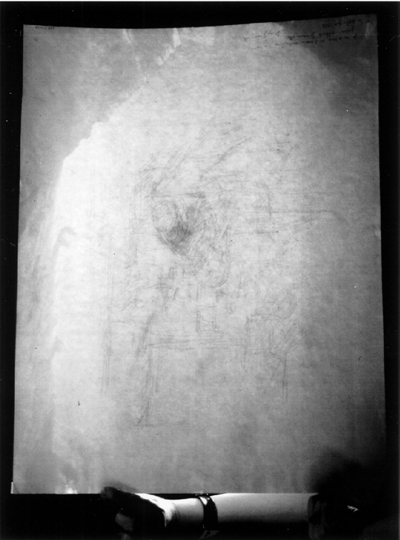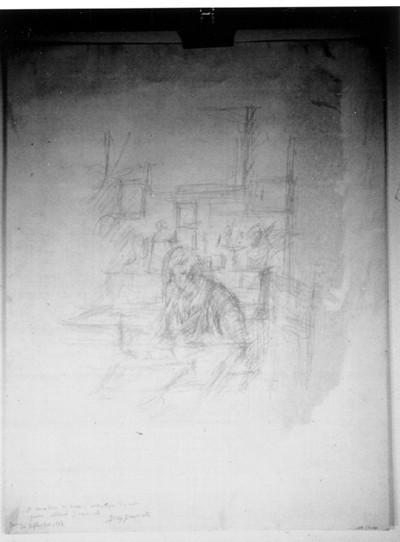PAPER SPLITTING: HISTORY AND MODERN TECHNOLOGYIRENE BR�CKLE, & JANA DAMBROGIO
6 6. DETECTING PREVIOUS SPLITTING TREATMENTSWhether a sheet of paper was split in the past may not always be immediately apparent—especially if it was split to separate recto and verso, if the treatment was done flawlessly, if information on the original characteristics of the paper is not available, or if an untreated artifact of similar makeup is not available for comparison. Even in cases where splitting was done clumsily and signs of past manipulation are noticeable, the paper's appearance might still lead to puzzling questions, as the following example illustrates. A drawing by Alberto Giacometti (1901–1966) on Rives BFK paper arrived at the laboratory of Swiss conservator Florence Darbre Gubbins. It was lined with a Western paper and showed an odd band of discoloration on the front (fig. 35) (Darbre Gubbins 1999). In transmitted light, the paper revealed severe uneven skinning, the thinnest area of which corresponded to the area of discoloration on the front (fig. 36). The surface of the drawing showed residual adhesive accretions and a slight, unnatural cloth pattern. From these phenomena, Darbre Gubbins concluded that the paper had been crudely split in order to separate it from another design on the verso—a likelihood given that Giacometti is known to have worked on both sides of a sheet of paper. Darbre Gubbins removed the mounting by peeling part of the backing paper off while the print was lightly dampened, then wetting the paper and peeling off the remaining backing paper while the wet print rested on top of a black glass plate. She evened out the skinned paper areas by applying a large complex pulp fill to the sheet verso, using a dropper while working on a suction table and checking the fill over a light box. The aqueous treatment was also successful in removing the discoloration and improving the paper surface texture.
The splitting of this drawing—which has had the good fortune of now being expertly conserved—brings to mind Morgana's cautionary thoughts about paper splitting: “The procedure seems to be very easy to do, but in reality some problems might occur from carelessness” (Morgana [1932] 1994, 89). The treatment of the Giacometti drawing is, thanks to its careful description by Florence Darbre Gubbins, an instructive case study. It might inspire a closer reading of the older literature on paper splitting with attention to those procedural details that might cause changes in the appearance of treated papers. They may not always be immediately explainable and may not even be very obvious: The original surface of paper that was split may show:
Paper that was split in order to permanently separate recto and verso may show:
Paper that was split to strengthen it by insertion of a core paper may show:
|

